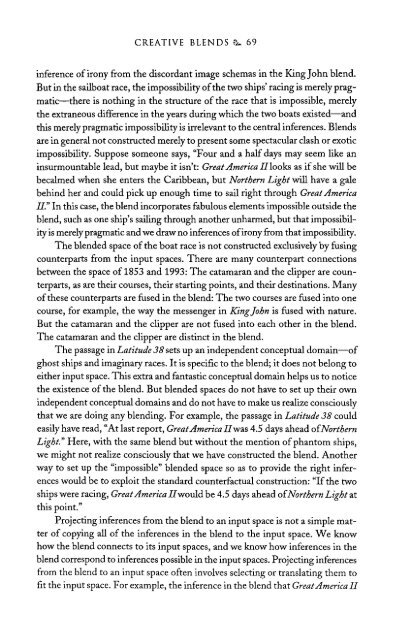The Literary Mind.pdf
The Literary Mind.pdf
The Literary Mind.pdf
You also want an ePaper? Increase the reach of your titles
YUMPU automatically turns print PDFs into web optimized ePapers that Google loves.
CREATIVE BLENDS 69<br />
inference of irony from the discordant image schemas in the King John blend.<br />
But in the sailboat race, the impossibility of the two ships' racing is merely pragmatic—there<br />
is nothing in the structure of the race that is impossible, merely<br />
the extraneous difference in the years during which the two boats existed—and<br />
this merely pragmatic impossibility is irrelevant to the central inferences. Blends<br />
are in general not constructed merely to present some spectacular clash or exotic<br />
impossibility. Suppose someone says, "Four and a half days may seem like an<br />
insurmountable lead, but maybe it isn't: Great America II looks as if she will be<br />
becalmed when she enters the Caribbean, but Northern Light will have a gale<br />
behind her and could pick up enough time to sail right through Great America<br />
II." In this case, the blend incorporates fabulous elements impossible outside the<br />
blend, such as one ship's sailing through another unharmed, but that impossibility<br />
is merely pragmatic and we draw no inferences of irony from that impossibility.<br />
<strong>The</strong> blended space of the boat race is not constructed exclusively by fusing<br />
counterparts from the input spaces. <strong>The</strong>re are many counterpart connections<br />
between the space of 1853 and 1993: <strong>The</strong> catamaran and the clipper are counterparts,<br />
as are their courses, their starting points, and their destinations. Many<br />
of these counterparts are fused in the blend: <strong>The</strong> two courses are fused into one<br />
course, for example, the way the messenger in King John is fused with nature.<br />
But the catamaran and the clipper are not fused into each other in the blend.<br />
<strong>The</strong> catamaran and the clipper are distinct in the blend.<br />
<strong>The</strong> passage in Latitude 38 sets up an independent conceptual domain—of<br />
ghost ships and imaginary races. It is specific to the blend; it does not belong to<br />
either input space. This extra and fantastic conceptual domain helps us to notice<br />
the existence of the blend. But blended spaces do not have to set up their own<br />
independent conceptual domains and do not have to make us realize consciously<br />
that we are doing any blending. For example, the passage in Latitude 38 could<br />
easily have read, "At last report, Great America II was 4.5 days ahead of Northern<br />
Light." Here, with the same blend but without the mention of phantom ships,<br />
we might not realize consciously that we have constructed the blend. Another<br />
way to set up the "impossible" blended space so as to provide the right inferences<br />
would be to exploit the standard counterfactual construction: "If the two<br />
ships were racing, Great America II would be 4.5 days ahead of Northern Light at<br />
this point."<br />
Projecting inferences from the blend to an input space is not a simple matter<br />
of copying all of the inferences in the blend to the input space. We know<br />
how the blend connects to its input spaces, and we know how inferences in the<br />
blend correspond to inferences possible in the input spaces. Projecting inferences<br />
from the blend to an input space often involves selecting or translating them to<br />
fit the input space. For example, the inference in the blend that Great America II















